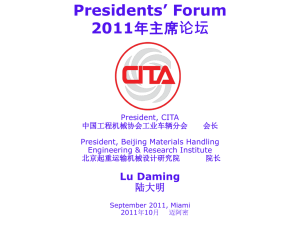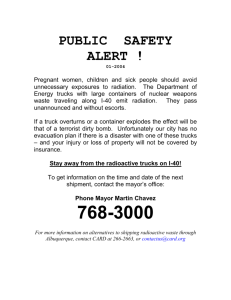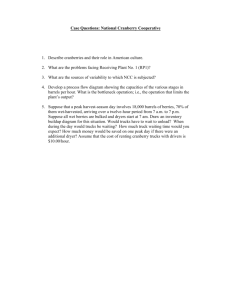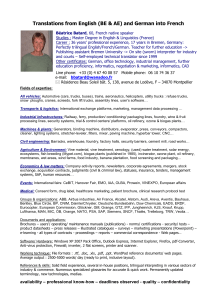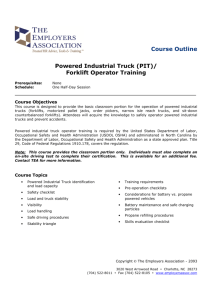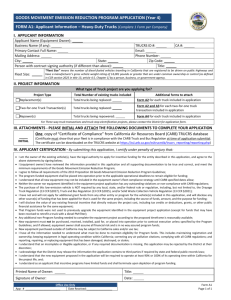effective life of trucks questionnaire
advertisement
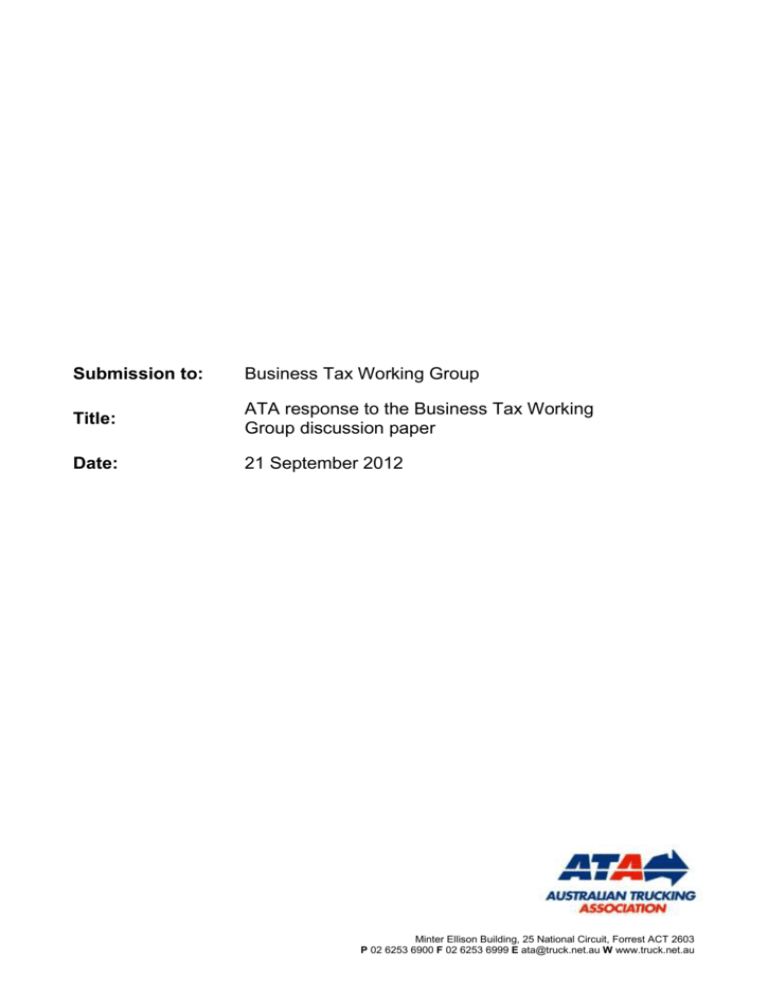
Submission to: Business Tax Working Group Title: ATA response to the Business Tax Working Group discussion paper Date: 21 September 2012 Minter Ellison Building, 25 National Circuit, Forrest ACT 2603 P 02 6253 6900 F 02 6253 6999 E ata@truck.net.au W www.truck.net.au ATA submission – BTWG discussion paper Page 2 Contents About the Australian Trucking Association.................................................................................................. 3 Summary .......................................................................................................................................................... 4 1. Introduction .............................................................................................................................................. 5 2. Evidence from trucking businesses ...................................................................................................... 6 Views about a cut to the company tax rate.................................................................................................... 6 Views about the impact of option B.6 ............................................................................................................ 7 3. Modelling the cash flow impact of option B.6 ...................................................................................... 7 Modelling results: prime movers .................................................................................................................... 8 Modelling results: rigid trucks ........................................................................................................................ 9 Implications of the modelling results ............................................................................................................ 10 4. Impact on road safety and the environment ....................................................................................... 10 How truck safety standards and emissions are regulated ........................................................................... 10 Age profile and turnover of the Australian truck fleet .................................................................................. 11 Truck safety standards ................................................................................................................................ 11 Emission standards ..................................................................................................................................... 13 5. Conclusion ............................................................................................................................................. 14 Attachment A: effective life of trucks questionnaire ................................................................................. 16 ATA submission – BTWG discussion paper Page 3 About the Australian Trucking Association The Australian Trucking Association is the peak body representing trucking operators. The ATA’s direct members include state and sector trucking associations, some of Australia’s major logistics companies and businesses with leading expertise in truck technology. In total, the ATA represents many thousands of trucking businesses, both large and small. ATA submission – BTWG discussion paper Page 4 Summary On 13 August 2012, the Business Tax Working Group (BTWG) released a discussion paper proposing that the company tax rate should be reduced from 30 to 25 per cent in the short to medium term. Its terms of reference required it to put forward savings to fully offset the cost of the rate cut, estimated at $26 billion over the forward estimates. One of the options in the paper, option B.6, would be to remove the statutory effective life caps for depreciating a range of transport assets, including aircraft, buses, ships, and trucks and trailers. Removing the caps on trucks and trailers would save $205 million over four years – 0.8 per cent of the savings required. This submission uses industry evidence and financial modelling to show that removing the statutory effective life caps on trucks and trailers would impose a significant cash flow burden on trucking businesses, despite the proposed cut in the company tax rate. The cash flow gap would be $4,163 per year for each typical prime mover. This cash flow gap would reduce operators’ ability to purchase new trucks and renew their fleets with the latest equipment. Vehicle safety and emission standards are imposed on new trucks, not on all trucks in service. As a result, slowing the rate of new truck purchases would slow the rate that safety and environmental standards are rolled out across Australia’s truck fleet. These standards aim to reduce the $17.85 billion yearly cost of road accidents and the $2.7 billion yearly cost of motor vehicle pollution. Slowing the rollout would delay their economic benefits, and would also conflict with existing Government policy. There are, in short, strong reasons to retain the existing statutory caps on the effective lives of trucks and trailers. The ATA accordingly recommends that: the BTWG should continue looking at options to reduce the company tax rate to 25 per cent but it should not further consider removing the statutory effective life caps on trucks and trailers, because: - the option would impose an additional cash flow burden on trucking businesses, which would reduce their ability to renew their fleets - it would slow the rollout of safety and environmental standards that aim to mitigate the $17.85 billion yearly cost of road accidents and the $2.7 billion yearly cost of motor vehicle pollution - it would conflict with the Government’s existing road safety and air pollution policies and - despite all these problems, it would only generate 0.8 per cent of the savings needed to offset the proposed company tax cut. ATA submission – BTWG discussion paper Page 5 1. Introduction On 13 August 2012, the Business Tax Working Group (BTWG) released a discussion paper proposing that the company tax rate should be reduced from 30 to 25 per cent in the short to medium term. Its terms of reference required it to put forward savings from within the business tax system to fully offset the cost of the rate cut, estimated at $26 billion over the years from 2012-13 to 2015-16.1 One of those options, option B.6, would be to remove the statutory effective life caps for a range of transport assets, including aircraft, buses, ships, and trucks and trailers. Option B.2 would also include the removal of these statutory caps. Table 1 shows the potential savings from option B.6 and the contribution from trucks and trailers. Table 1: cost savings from option B.6 2012-13 to 2015-16 ($m) 455 205 All affected assets Trucks and trailers Share of total savings required (Per cent) 1.8 0.8 Sources: BTWG discussion paper (p31), Commonwealth Treasury. Table 2 sets out the impact of the option on the effective lives used to depreciate trucks and trailers. Table 2: impact of option B.6 on effective lives Trucks having a gross vehicle mass greater than 3.5 tonnes (other than a truck that is used in mining operations and that is not of a kind that can be registered to be driven on a public road in the place in which the truck is operated) Trailers with a gross vehicle mass greater than 4.5 tonnes Current effective life (statutory cap) 7.5 years Effective life under option B.6 (ATO determination) 15 years 10 years 15 years Source: Australian Taxation Office Option B.6 re-litigates a tax policy debate that occurred between 2003 and 2005, after the ATO reviewed Taxation Ruling TR2000/18, which set the effective life of trucks at five years. As a result of the review, the ATO set the effective lives of both trucks and trailers at 15 years, despite a KPMG report concluding that: A road transport operator acquiring prime movers after the implementation of a fifteen year effective life regime would need to fund an after tax cash flow gap of around $8,800 per year for each truck. The proposed effective life of fifteen years was not consistent with the expected actual usage and value diminution of trucks. An increase in effective life would lead to road transport businesses deferring the acquisition of new trucks, delaying the introduction of safer and more environmentally friendly vehicles.2 Parliament subsequently imposed the current statutory caps on the effective lives of trucks and trailers, which took effect on 1 January 2005. 1 2 Business Tax Working Group (BTWG), Discussion Paper, 13 August 2012, p24. KPMG, The Effective Life of Trucks. KPMG, Melbourne, 2004, pp1-2. The report was commissioned by the ATA. ATA submission – BTWG discussion paper Page 6 In its discussion paper, the BTWG conceded that some of the options it is considering would involve reversing measures that have only recently been enacted. 3 The inclusion of trucks and trailers in option B.6 is an example. The discussion paper also noted there may well be circumstances where a departure from a uniform tax base could be justified on economic grounds (such as encouraging activities that give rise to positive social benefits).4 This submission reports on the views of trucking operators about a cut to the company tax rate and option B.6 (section 2). It uses evidence provided by those operators to model the cash flow impacts of option B.6 (section 3), before examining the broader safety and environmental problems associated with the option (section 4). The submission concludes (in section 5) that there are strong reasons to depart from the proposed uniform tax rate by retaining the statutory caps on the effective lives of trucks and trailers. 2. Evidence from trucking businesses To support the development of this submission, the ATA circulated a questionnaire to trucking businesses through its member associations. The questionnaire (attachment A) asked the businesses to provide detailed responses to 20 tax and financial questions. Because of the sensitivity of the questions, the ATA assured businesses their responses would be treated in confidence and would be rounded and de-identified before use. The ATA received completed questionnaires from eleven businesses, ranging from national logistics groups through to firms with fewer than twenty trucks. Views about a cut to the company tax rate The businesses who responded to the questionnaire were near unanimous in their support for the option of cutting the company tax rate to 25 per cent. Many of these businesses, though, were very concerned about the possibility of losing the statutory effective life caps as a result of option B.6: We have undertaken a relatively high level modelling analysis and advise that only if there is at least a 2% reduction in the corporate tax rate would [redacted] generate a better after tax position for the group, if the rate reduction was funded by the removal of statutory caps and/or the move from a 200% DV rate approach to a 150% DV rate. [National logistics group] For a growing younger business, this [ie: option B.6] would cripple them. Established companies can absorb tax when they own equipment. This method goes against small to medium business. [Livestock transport business, NSW] We would prefer to retain the effective life caps rather than see a lowering of the company tax rate. [Qld/NSW linehaul freight operator] 3 4 BTWG, p22. BTWG, p3. ATA submission – BTWG discussion paper Page 7 Views about the impact of option B.6 A number of the operators put the view that they would need to reduce their capital expenditure to manage the cash flow impact of option B.6 We will be forced to reduce our capital expenditure. [Qld/NSW linehaul freight operator] Over time it would greatly impact our cash flow as less is received for depreciation. We endeavour to match the finance term with the effective life so the P&L expense roughly matches the cash outflow of the repayments. Stretching the effective life means we will be paying out more than is being expensed which is a trap for businesses running the risk of thinking they are doing ok from a profit perspective however cash will be drained at a greater rate than the profit is generated. It is likely that we would buy less equipment and try to stretch the life of the equipment we have further. This will impact manufacturers and mean more carbon efficient vehicles are not being purchased. [National linehaul freight operator] But for one business servicing the mining industry, option B.6 would make no difference – except in its tax compliance paperwork: It would have no effect because we would have to self-assess the effective life of an asset and as a result we would use the rates of depreciation that we are currently using. Doubling of the effective life of assets as proposed would not reflect an accurate position in our business. [Mining industry and heavy haulage specialist, WA] 3. Modelling the cash flow impact of option B.6 To quantify the views set out in section 2, the ATA modelled the cash flow impact of option B.6 using information provided by the businesses that responded to the questionnaire. Table 3 summarises the evidence they provided: Table 3: Indicative truck costs, time in use and disposal prices Prime movers Estimated cost of a new prime mover (excl GST) Company policy on time in use Estimated sale value (excl GST) Rigid trucks Estimated cost of a new rigid truck (excl GST) Company policy on time in use Estimated sale value (excl GST) Modelling assumptions Cash rate Company tax rate, in line with BTWG options paper Diminishing value rate, in line with option B.1 Response range Indicative value for modelling $215,000-$380,000 4-10 years $25,000-$136,000 $250,000 5 years $90,000 $70,000-$136,000 10 years $23,000-$45,000 $100,000 10 years $30,000 10 per cent 25 per cent 150 per cent ATA submission – BTWG discussion paper Page 8 Modelling results: prime movers Figure 1 sets out the cash flow impact of option B.6 on an indicative prime mover depreciated using the prime cost method. Using the existing 7.5 year effective life, the prime cost depreciation on this prime mover would be $33,325 per year, compared to $16,675 per year under a 15 year effective life. Once the proposed 25 per cent company tax rate is taken into account, the after tax cash flow difference between an effective life of 7.5 years and an effective life of 15 years would be $4,163 per year. On a net present value basis, the cash flow gap over the five year ownership of the truck would be $17,357. Figure 1: Indicative prime mover, discounted cash flow after tax, prime cost method $20,000 $15,000 $10,000 $5,000 $0 -$5,000 Year 1 Year 2 7.5yrs PV Year 3 15yrs PV Year 4 Year 5 Disposal Cumulative gap Figure 2 sets out the modelling results for a business depreciating an indicative prime mover using the diminishing value method. The modelling is based on a 150 per cent diminishing value rate, for consistency with option B.1 in the BTWG discussion paper. Using the existing 7.5 year effective life, the diminishing value depreciation on this prime mover would start at $50,000 in year one, declining to $20,480 in year five. Under a 15 year effective life, the diminishing value depreciation would start at $25,000 and decline to $16,403 in year five. Once the proposed 25 per cent company tax rate is taken into account, the after tax cash flow difference between an effective life of 7.5 years and an effective life of 15 years would start at $6,250 per year. On a net present value basis, the cash flow gap over the five year ownership of the truck would be $14,736. ATA submission – BTWG discussion paper Page 9 Figure 2: Indicative prime mover, discounted cash flow after tax, diminishing value method $20,000 $15,000 $10,000 $5,000 $0 -$5,000 Year 1 Year 2 Year 3 7.5yrs PV (25%) Year 4 15yrs PV (25%) Year 5 Disposal Cumulative gap 25% tax rate Modelling results: rigid trucks Figure 3 sets out the cash flow impact of option B.6 on an indicative rigid truck depreciated using the prime cost method. Using the existing 7.5 year effective life, the prime cost depreciation on this rigid truck would be $13,330 per year, compared to $6,670 per year under a 15 year effective life. Once the proposed 25 per cent company tax rate is taken into account, the after tax cash flow difference between an effective life of 7.5 years and an effective life of 15 years would be $1,665 per year. On a net present value basis, the cumulative cash flow gap over the ten year ownership of the truck would be $7,434. Figure 3: Indicative rigid truck, discounted cash flow after tax, prime cost method $10,000 $8,000 $6,000 $4,000 $2,000 $0 -$2,000 -$4,000 Year 1 Year 2 Year 3 Year 4 7.5yrs PV Year 5 Year 6 15yrs PV Year 7 Year 8 Year 9 Year 10 Disposal Cumulative gap If the same truck was depreciated using the diminishing value method at 150 per cent (figure 4), its depreciation using a 7.5 year effective life would start at $20,000 in year one, declining to $2,684 in year ten. Under a 15 year effective life, its depreciation would start at $10,000 and decline to $4,305 in year ten. Once the proposed 25 per cent company tax rate is taken into account, the after tax cash flow difference between an effective life of 7½ years and an effective life of 15 years would start at $2,500 in year one. On a net present value basis, the cumulative cash flow gap over the ten year ownership of the truck would be $5,571. ATA submission – BTWG discussion paper Page 10 Figure 4: Indicative rigid truck, discounted cash flow after tax, diminishing value method $10,000 $8,000 $6,000 $4,000 $2,000 $0 -$2,000 -$4,000 Year 1 Year 2 Year 3 Year 4 7.5yrs PV Year 5 Year 6 15yrs PV Year 7 Year 8 Year 9 Year 10 Disposal Cumulative gap Implications of the modelling results The modelling results confirm and quantify the concerns raised by trucking operators in section 2. At the proposed 25 per cent tax rate, option B.6 would expose an incorporated trucking business using the prime cost method to an after tax cash flow gap of $4,163 per indicative prime mover each year, or $17,357 on an NPV basis. It would face an after tax cash flow gap of $1,665 per indicative rigid truck per year, or $7434 on an NPV basis. For any given capital expenditure budget, option B.6 would reduce operators’ ability to purchase new trucks. It would force them to slow their purchases of new trucks, keep their trucks for longer or reduce their maintenance expenditure to make up the shortfall. It could be argued that trucking businesses could simply raise their rates to make up the cashflow gap. In reality, this would not be an option for most trucking businesses: the industry is hypercompetitive and mainly consists of small to medium businesses with a limited ability to raise their prices. It could also be argued that trucking businesses could self-assess the effective lives of their vehicles. Although some businesses, such as the mining industry specialist quoted in section 2, have the ability to self-assess, the vast majority of small to medium businesses do not have the resources or accounting expertise on hand that is required. The 2004 KPMG report examined the difficulties with self-assessment in detail.5 Section 4 of this submission examines the impact of a slowdown of new truck purchases on road safety and the environment. 4. Impact on road safety and the environment How truck safety standards and emissions are regulated Truck safety standards and environmental emissions are regulated through the Australian Design Rules (ADRs), which are administered by the Federal Department of Infrastructure and Transport under the Motor Vehicle Standards Act 1989. Under the Act, all new and used imported vehicles must comply with the relevant ADRs at the time they are first supplied to the Australian market. New standards do not apply retrospectively to vehicles already in service. 5 KPMG 2004, pp21-22. ATA submission – BTWG discussion paper Page 11 As a result, the rollout of truck safety and environmental standards across the fleet – and the realisation of the economic and social benefits of those standards – depends on the rate that operators purchase new vehicles and turn over their fleets. Age profile and turnover of the Australian truck fleet Table 4 shows the age profile of Australia’s truck fleet. Although the fleet includes some 135,000 trucks manufactured in the last five years, 37.6 per cent of the fleet was manufactured before 1996, giving the Australian fleet a rather older average age than the fleets of comparable countries. For example, the average age of articulated trucks in Australia is 11.5 years, compared to less than seven years for heavy trucks in the United States. This is partly because Australia is a closed system: there are few or no opportunities to export older vehicles to third world markets.6 Table 4: Age profile of the Australian truck fleet Year of manufacture Rigid trucks To 1996 176,322 1997-2001 59,974 2002-2006 100,482 2007-2011 108,579 2012 148 Not stated 901 Total 446,406 Per cent 39.5 13.4 22.5 24.3 0.0 0.2 100.0 Articulated trucks 24,567 12,946 23,736 26,609 75 62 87,995 Per cent 27.9 14.7 27.0 30.2 0.1 0.1 100.0 Total fleet 200,889 72,920 124,218 135,188 223 963 534,401 Per cent 37.6 13.6 23.2 25.3 0.0 0.2 100.0 Source: Australian Bureau of Statistics, Motor Vehicle Census, (Cat 9309.0), 31 Jan 2012. Trucks cascade through a series of owners and tasks during their lives. For example, articulated trucks are typically purchased new for long haul work, before being sold when they start to require increased maintenance to undertake short haul and local tasks. As table 1 shows, purchasers of new prime movers typically sell them to their next owner after 4-10 years. New rigid trucks are typically sold after ten years of service. Truck safety standards Why truck safety standards are important The trucking industry’s safety has improved dramatically in the last thirty years. In 2011, the University of Adelaide’s Centre for Automotive Safety Research reported that the fatal crash rate for articulated trucks improved 60 per cent since between 1982 and 2007. The report found the most significant gains in truck safety during this period were due to broad road safety initiatives that have improved safety for all road users, particularly improvements to the road network (including divided highways and sealed shoulders), reduced speed limits – and improvements in vehicle design.7 Even though road safety has improved – for example, the 2011 road toll was the lowest since 1946 8 – vehicle accidents continue to impose an enormous economic and social cost. The estimated social cost of road crashes in 2006 was $17.85 billion, or 1.7 per cent of GDP. 9 6 The Centre for International Economics, Environmental Credentials of the Australian Trucking Industry. CIE, Canberra, 2011. p40. The report was commissioned by the ATA. 7 Raftery, S et al, Heavy vehicle road safety: research scan. CASR report 100, July 2011. Centre for Automotive Safety Research, Adelaide, 2011. p2. The report was commissioned by the ATA. 8 King, C, “Australian road deaths continue to fall,” Media release, 25 January 2012. 9 Bureau of Infrastructure, Transport and Regional Economics, Cost of road crashes in Australia 2006. Research report 118. BITRE, Canberra, 2010. p83. ATA submission – BTWG discussion paper Page 12 Improvements in truck safety standards and the rollout of new safety features by manufacturers contribute to reducing this economic cost and the trauma of road accidents. Safety measures implemented through the ADRs The ADRs impose a host of mandatory safety features on trucks. A recent high profile example is ADR 84/00, which requires trucks weighing more than 12 tonnes to be fitted with front underrun protection devices to prevent pedestrians and light vehicles sliding under their wheels in a collision. According to the regulation impact statement for the rule, about 35 people were killed each year between 1988 and 2003 in underrun crashes. It estimated the cost of heavy commercial vehicle underrun trauma at $295 million per year, 10 and estimated that the rule would deliver net benefits of $24.6 million per year.11 The rule applies to all new model trucks manufactured after 1 January 2011, and all new trucks manufactured after 1 January 2012. It does not apply retrospectively to any of the trucks manufactured before 2011. Its rollout across the fleet will occur at the rate that trucking operators purchase new equipment and re-sell it on the second hand market. Safety features implemented by manufacturers In addition to the safety measures imposed through the ADR system, some truck manufacturers offer a range of additional safety features in their vehicles. These safety features can match or exceed those found in the most expensive cars and can include: adaptive cruise control, which slows the truck automatically if the vehicle in front slows lane departure warning systems, which warn the driver if the truck veers from its lane electronic stability control to reduce rollover accidents and blind spot radar, to warn the driver if there is a car in the truck’s left hand blind spot. These features cannot be retrofitted into older model trucks and are not available on all new trucks. Again, their rollout across the fleet will depend on the rate that trucking operators purchase new equipment. Government policy The Australian Government’s policy on the rollout of additional truck safety features is set out in the National Road Safety Strategy 2011-2020, released in May 2011.12 The strategy aims to achieve a reduction in the average fleet age in Australia, and a substantial increase in the proportion of heavy vehicles with advanced braking systems and other safety technologies. In the years to 2014, this is to include mandating ABS/load proportioning brake systems for heavy vehicles and trailers, and considering regulatory impact statements for increased heavy vehicle cabin strength, ESC and lane departure warning systems. The strategy commits the Government to investigate incentives relating to vehicle purchases (including tax based incentives) and to promote options that encourage the purchase of safer vehicles and greater turnover of the vehicle fleet.13 10 Department of Infrastructure, Transport, Regional Development and Local Government, Regulation impact statement for underrun protection, DITRE, Canberra, 2009. p6. 11 DITRDLG, 2009, p54. 12 Australian Transport Council, National road safety strategy 2011-2020. 13 ATC, pp75-77. ATA submission – BTWG discussion paper Page 13 Emission standards Impact of vehicle emissions on health The impact of vehicle emissions on health has been well established. In 2005, the former BTRE examined a series of international studies and pointed out that: carbon monoxide reduces the amount of oxygen carried by the blood, and roads with heavy traffic can generate carbon monoxide levels high enough to cause cardiovascular and behavioural effects nitrogen dioxide – the cause of the smog in Australia’s capital cities – may increase susceptibility to infection and worsen asthma symptoms particulate matter has significant health impacts, including asthma and the increased risk of premature mortality, especially in the very young and the elderly. 14 The BTRE estimated that motor traffic pollution was responsible for 900-2,000 premature deaths each year, 900-4,500 hospital admissions and 1,400-2,000 asthma attacks, with a total economic cost of $2.7 billion per year.15 Emission controls implemented through the ADRs To mitigate the health impacts of motor vehicle pollution, a series of four ADRs (70/00, 80/00, 80/02 and 80/03) have imposed increasingly stringent standards on the emissions of carbon monoxide (CO), hydrocarbons (HC), nitrogen oxides (NOx) and particulate matter (PM) by trucks. Table 5 sets out the emission reductions delivered by these standards. Table 5: Emission reductions delivered through the ADR system Per cent reduction compared to ADR 70/00 Standard Year of effect* CO HC NOx 70/00 1995/1996 80/00 2002/2003 -29 -38 80/02 2007/2008 -11 -50 -56 80/03 2010/2011 -11 -50 -75 PM -56 -92 -92 *The first year shows when the standard applied to new model vehicles; the second year shows when it applied to all new vehicles. Source: Department of Infrastructure and Transport Complying with these rules has involved an enormous investment by trucking operators as they purchase new equipment. It also involves ongoing business expenses. For example, trucks that use selective catalytic reduction (SCR) technology require the use of a urea additive, AdBlue. AdBlue costs well over a dollar a litre, and SCR trucks use about 5 litres of AdBlue for every 100 litres of diesel. As with the safety rules, these ADRs only apply to new and imported second hand trucks. They do not apply retrospectively to older vehicles, with the result, again, that the rollout of these standards depends on the rate that businesses purchase new trucks. Figure 6 highlights the scale of the task to bring the whole of the truck fleet up to even the oldest of the environmental standards. 14 Bureau of Transport and Regional Economics, Health impacts of transport emissions in Australia: economic costs. BTRE, Canberra, 2005. pp52-54. 15 BTRE 2005, p105. ATA submission – BTWG discussion paper Page 14 Figure 5: Australian truck fleet: trucks subject to emission standards ADR 80/03 9% ADR 80/02 17% No emission standard 33% ADR 80/00 23% ADR 70/00 18% Source: ABS 2012, datacubes. Government policy The Australian Government is considering introducing a new ADR, ADR 80/04, based on the Euro VI design standard. The new ADR would impose even more stringent standards on truck emissions. A draft RIS is expected to be released in the first half of 2013. 16 The new ADR would only apply to new trucks, not the trucks currently in service. 5. Conclusion In its discussion paper, the BTWG noted there may well be circumstances where a departure from a uniform tax base can be justified on economic grounds (such as encouraging activities that give rise to positive social benefits). This submission shows that removing the statutory effective life caps on trucks and trailers, as proposed in option B.6, would impose a cash flow burden on operators despite the proposed cut in the company tax rate. The cash flow burden would amount to $4,163 per year for each indicative prime mover depreciated using the prime cost method. For any given capital expenditure program, the cash flow gap would reduce operators’ ability to purchase new trucks and renew their fleets with the latest equipment. Vehicle safety and emission standards are imposed on new and imported second hand trucks, not on all trucks in service. As a result, slowing the rate of new truck purchases would slow the rate that safety and environmental standards are rolled out across Australia’s truck fleet. These standards aim to reduce the $17.85 billion yearly cost of road accidents and the $2.7 billion yearly cost of motor vehicle pollution. Slowing the rollout would delay their economic benefits, and would also conflict with existing Government policy. There are, in short, strong reasons to retain the existing statutory caps on the effective lives of trucks and trailers. 16 Department of Infrastructure and Transport, Annual regulatory plan 2012-13. DIT, Canberra, 2012. p52. ATA submission – BTWG discussion paper The ATA accordingly recommends that: the BTWG should continue looking at options to reduce the company tax rate to 25 per cent but it should not further consider removing the statutory effective life caps on trucks and trailers, because: - the option would impose an additional cash flow burden on trucking businesses, which would reduce their ability to renew their fleets - it would slow the rollout of safety and environmental standards that aim to mitigate the $17.85 billion yearly cost of road accidents and the $2.7 billion yearly cost of motor vehicle pollution - it would conflict with the Government’s existing road safety and air pollution policies and - despite all these problems, it would only generate 0.8 per cent of the savings needed to offset the proposed company tax cut. Page 15 Attachment A: effective life of trucks questionnaire INSERT ASSOCIATION LOGO HERE EFFECTIVE LIFE OF TRUCKS REFERENCE GROUP The Australian Government’s Business Tax Working Group (BTWG) has raised, as an option, removing the statutory caps on the effective lives of trucks and trailers. If this was implemented: the effective life of a prime mover or rigid truck would increase from 7½ years to 15 years for depreciation purposes. the effective life of a trailer would increase from 10 years to 15 years. We would like to get your input to help develop the industry’s submission in response to this option. This would involve asking your chief financial officer, finance manager or accountant to prepare responses to some technical questions. We may need to discuss your responses on the phone, and would also like you to review a draft of the submission, once prepared. Your time commitment would be small, but vital. We need your help to prepare the best argument we can against this option. If you would like to participate, would you please provide responses to the following questions and send them to Sarah Harber (sarah.harber@truck.net.au) by Wednesday 12 September? All responses will be treated in confidence, and rounded and de-identified before they are used. Please contact Bill McKinley or Sarah Harber on (02) 6253 6900 if you have any questions. Current accounting policies 1. Do you self-assess the effective lives of your vehicles for depreciation purposes, or do you use the safe harbour of the statutory effective life caps? Response: 2. If you do self-assess the effective life of your vehicles, what is your write down rate e.g. 10% per year? Response: ATA submission – BTWG discussion paper Page 17 IN-CONFIDENCE WHEN COMPLETED 3. Do you have different depreciation rates for different classes of vehicles of equipment? Response: 4. Are you in the simplified tax system? Response: 5. Do you use the prime cost or diminishing value method for depreciating your vehicles? Response: Capital expenditure plans 6. What is your planned capital expenditure on new trucks in 2013-14, 2014-15 and 2015-16? Response: 7. How many new trucks do you plan to purchase in 2013-14, 2014-15 and 2015-16? Response: 8. What is your planned capital expenditure on new trailers in 2013-14, 2014-15 and 2015-16? Response: 9. How many new trailers do you plan to purchase in 2013-14, 2014-15 and 2015-16? Response: 10. How much would you typically expect to pay for a new truck? Response: ATA submission – BTWG discussion paper Page 18 IN-CONFIDENCE WHEN COMPLETED 11. How much would you typically expect to pay for a new trailer? Response: Vehicle disposal/maintenance policies 12. How long do you typically keep new trucks before you sell them on, and how many kilometres have they typically travelled by that stage? Response: 13. What would you typically expect to receive for one of your trucks when it is sold? Response: 14. How long do you typically keep new trailers before you sell them on, and how many kilometres would they have typically travelled by that stage? Response: 15. What would you typically expect to receive for one of your trailers when it is sold? Response: 16. During the period you own them, what are the indicative major maintenance costs for your trucks? Response: 17. During the period you own them, what are the indicative major maintenance costs for your trailers? Response: ATA submission – BTWG discussion paper Page 19 IN-CONFIDENCE WHEN COMPLETED Impact of removing the effective life caps 18. Assuming your business maintains its total capital expenditure, what impact would the possible removal of the effective life caps have on your purchase of new trucks and trailers? Response: 19. Would the proposal lead you to consider self-assessing the effective lives of your vehicles rather than using the Commissioner’s effective life determinations? Response: Impact of a possible reduction in the company tax rate 20. The Business Tax Working Group has proposed removing the effective life caps as part of a package of savings to offset the cost of a 5 percentage point reduction in the company tax rate, from 30 per cent to 25 per cent. As far as your business is concerned, would this possible reduction in the company tax rate offset the impact of the removal of the effective life caps? Response:

